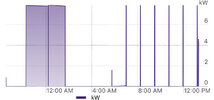Hello,
I noticed by keeping my car plugged in throughout the day and set to 80% charge limit makes it so that the charger keeps charging the car throughout the entire day. Is this good for the car?
As you can see in the attached photo the spikes throughout the day are the car charging. I’m not sure if this is alright or will it mess my battery up.
I noticed by keeping my car plugged in throughout the day and set to 80% charge limit makes it so that the charger keeps charging the car throughout the entire day. Is this good for the car?
As you can see in the attached photo the spikes throughout the day are the car charging. I’m not sure if this is alright or will it mess my battery up.



